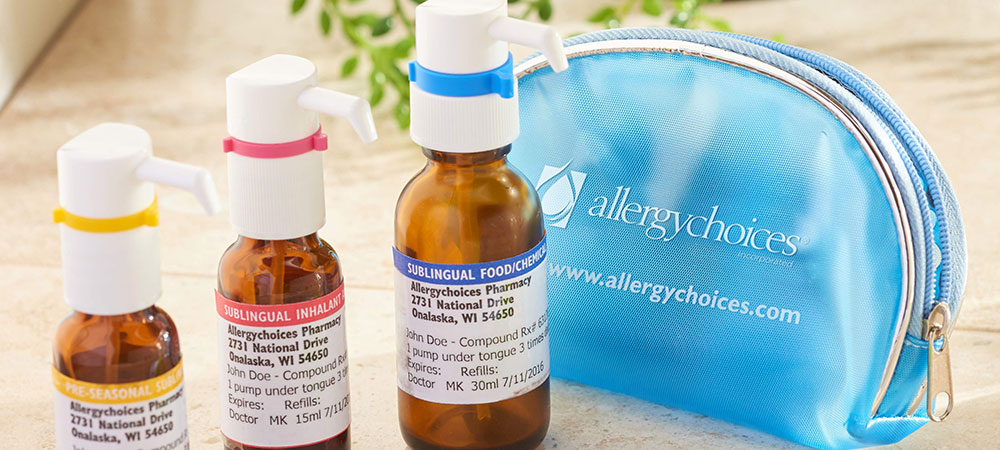What to Know About Personalized Sublingual Immunotherapy

Allergies are the 6th leading cause of chronic illness in the U.S. A majority of people avoid their allergens, manage their symptoms with temporary relief from over-the-counter (OTC) allergy medications, or just continue to suffer. Did you know there’s a personalized treatment to modify allergies and allergy-related chronic conditions beyond temporary relief?
In this blog, we’ll explain personalized sublingual immunotherapy (also known as allergy drops), what makes it different from other allergy treatment options, who may benefit from sublingual immunotherapy, and how to take allergy drops.
What is sublingual immunotherapy, or allergy drops? And, what’s the difference with personalized drops?
Sublingual immunotherapy is a safe, convenient, and effective allergy treatment that treats the cause of allergies using the same FDA approved antigens as subcutaneous immunotherapy, or allergy shots. The difference is allergy drops can treat a broader range of patients and are taken under the tongue at home, rather than through injections in a medical clinic.
Delivering antigens under your tongue is effective because that is where the body’s highest amount of antigen presenting cells (dendritic cells) are located. Dendritic cells act as messengers delivering antigens (substances you’re allergic to) to the cells that help your body build tolerance to your allergens.
But, not all sublingual immunotherapy is the same. Personalized allergy drops following the La Crosse Method™ Protocol are based on each patient’s “allergic fingerprint.” Your provider will review your medical history, complete a thorough exam, and perform allergy testing to determine your unique “allergic fingerprint.” This will be used to develop allergy drops specific to your allergens and level of sensitivity to each allergen — and can even treat multiple allergies at the same time.
The optimal, personalized dosing offers a better safety margin so you can build tolerance to your allergens without experiencing reactions from unnecessarily high doses.
Who may benefit from sublingual immunotherapy?
One of the major benefits of personalized sublingual immunotherapy is the range of patients who may benefit from the treatment:
- Infants and children
- Severe asthmatics
- Patients with chronic conditions, such as chronic sinusitis
- Food and mold allergic patients
- Needle-sensitive patients
- Patients with multiple allergies
Patients battling various allergy-related conditions may also benefit since an underlying allergy can trigger some chronic health problems:
- Allergic rhinitis
- Asthma
- Atopic dermatitis/eczema
- Dust mite and environmental allergies
- Headaches
- IBS
- Pet & animal allergies
According to the Asthma and Allergy Foundation of America, allergic asthma accounts for approximately 60% of asthma cases. Another common allergy-related chronic condition is sinusitis. Since allergies already cause inflammation in the sinus cavities, allergy sufferers are more likely to develop chronic sinusitis than people without allergies. This is just a glimpse into a couple allergy-related conditions, and why treating an underlying allergy with sublingual immunotherapy may help improve outcomes for more than just your typical allergy symptoms.
How is sublingual immunotherapy different from OTC allergy medications?
Sublingual immunotherapy gradually changes allergic disease; OTC medications only temporarily mask symptoms.
As your body builds tolerance to your allergens, your immune system gradually changes how it reacts to those substances. The major benefit of allergy immunotherapy is the long-lasting relief that can be permanent for some patients after treatment is completed.
During treatment with drops, you may still take OTC allergy medications to help you get through peak allergy seasons or while your body is building tolerance to your allergens. However, most patients report using fewer or no allergy-related OTC medications after treatment is underway.
Sublingual immunotherapy can also slow or stop conditions like asthma, eczema, and sinusitis from developing. On the other hand, OTC allergy medications only give temporary symptom relief and do not treat the cause of allergy or related conditions.
When/how will I take my allergy drops?
You can conveniently take three doses of allergy drops daily, wherever you are — at home, work, school, or even on vacation. Treatment typically lasts three to five years depending on your specific allergies and adherence to treatment. Many patients feel better within a few weeks or months, but it’s important to continue taking your allergy drops through all three phases for better, long-lasting results.
Allergy drops come in a metered pump bottle to ensure precise dosing. To take a dose, hook the pump on your bottom teeth and release one full depression of the dispenser, which places the allergy drop under your tongue. Wait 20-30 seconds, then swallow — it’s that simple! If you’re treating environmental and food allergies, you’ll have two separate bottles, but can take them at the same time.
Watch how to take your allergy drops:
Each prescription refill lasts approximately 90 days; your prescriptions are made stronger over time as you begin tolerating your allergens. Your daily dosage instructions remain the same throughout all phases of treatment.
Where can I learn more about personalized sublingual immunotherapy following the La Crosse Method Protocol?
Over 2,000 providers across the U.S. have been trained in the La Crosse Method Protocol, benefiting more than 275,000 patients.
Ready to treat the cause of your allergy or learn more? Find a provider near you who can help you start the journey of modifying your allergies. Or, view research supporting sublingual immunotherapy if you’d like to learn how you might begin to change your allergies for good.





